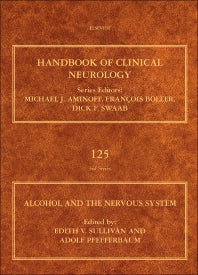Freshly Printed - allow 10 days lead
Couldn't load pickup availability
Alcohol and the Nervous System
A collection of review articles focused on alcohol and the central nervous system
Edith V. Sullivan (Edited by), Adolf Pfefferbaum (Edited by)
9780444626196, Elsevier Science
Hardback, published 25 November 2014
704 pages, Approx. 110 illustrations (40 in full color)
26 x 18.3 x 3.7 cm, 2.09 kg
Alcohol is the most widely used drug in the world, yet alcoholism remains a serious addiction affecting nearly 20 million Americans. Our current understanding of alcohol's effect on brain structure and related functional damage is being revolutionized by genetic research, basic neuroscience, brain imaging science, and systematic study of cognitive, sensory, and motor abilities. Volume 125 of the Handbook of Clinical Neurology is a comprehensive, in-depth treatise of studies on alcohol and the brain covering the basic understanding of alcohol's effect on the central nervous system, the diagnosis and treatment of alcoholism, and prospect for recovery. The chapters within will be of interest to clinical neurologists, neuropsychologists, and researchers in all facets and levels of the neuroscience of alcohol and alcoholism.
Section 1 Introduction 1. Alcoholism: diagnosis, prognosis, epidemiology, and burden of the disease 2. Perspectives on the Neuroscience of Alcohol from the National Institute on Alcohol Abuse and Alcoholism Section 2 Animal Models: Neurochemistry and Metabolism of Alcohol 3. Neurocircuitry of Alcoholism: Synthesis from Animal Models 4. Metabolism 5. Use of animal models of alcohol-related behavior Section 3 Molecular Basis of Alcoholism 6. Molecular Basis of Alcoholism Section 4 Neurological Signs and Consequences 7. Acute: Intoxication and Poisoning--Diagnosis and Treatment 8. Acute: Withdrawal--Diagnosis and Treatment 9. Neurochemical mechanisms of alcohol withdrawal 10. Molecular and neurological responses to chronic alcohol use Section 5 Neuropsychology 11. Methods of Association and Dissociation for Establishing Selective Brain-Behavior Relations 12. Profiles of impaired, spared, and recovered neuropsychological processes in alcoholism 13. Component processes of memory in alcoholism: pattern of compromise and neural substrates 14. Decision Making, Risky Behavior, and Alcoholism 15. Motor Systems and Postural Instability 16. Sex differences in alcohol-related neurobehavioral consequences Section 6 Neuroimaging of Brain Macrostructure and Microstructure 17. Structural and microstructural imaging of the brain in alcohol use disorders Section 7 Neuroimaging of Neurochemical Markers 18. Molecular imaging in alcohol dependence 19. Brain proton magnetic resonance spectroscopy of alcohol use disorders Section 8 Neuroimaging of Brain Function 20. Cognition, emotion, and attention 21. The neurobiology of alcohol craving and relapse 22. Compensatory recruitment of neural resources in chronic alcoholism Section 9 Neuroelectrophysiology 23. Understanding alcohol use disorders with neuroelectrophysiology 24. Sleeping EEG Section 10 Fetal Alcohol Spectrum Disorder 25. Neurobehavioral, neurological, and neuroimaging characteristics of fetal alcohol spectrum disorders 26. Fetal alcohol spectrum disorder: pathogenesis and mechanisms 27. Current hypotheses on the mechanisms of alcoholism Section 11 Adolescent Drinking 28. The effect of alcohol use on human adolescent brain structures and systems Section 12 Other topics 29. Peripheral Systems: Neuropathy 30. Pharmacological treatment of alcoholism 31. Alcohol-Medical Drug Interactions 32. Genetics of alcoholism 33. Co-occurring psychiatric disorders and alcoholism 34. Hepatic encephalopathy in alcoholic cirrhosis 35. Neuropathology of Alcoholism 36. Genetic differences in response to alcohol 37. Epidemiology of drinking, alcohol use disorders, and related problems 38. Alcohol and the law 39. Clinical Management of Alcohol Use Disorders in the Neurology Clinic
Subject Areas: Addiction & therapy [MMZR], Neurology & clinical neurophysiology [MJN]


